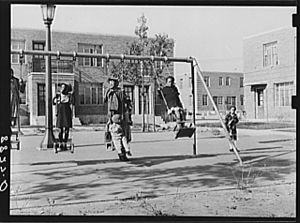Logan Fontenelle Housing Project facts for kids
The Logan Fontenelle Housing Project was a historic group of homes in Omaha, Nebraska, United States. It was located in the Near North Side neighborhood. The project was built in 1938 by the Public Works Administration. It was meant to house working-class families. In the 1950s and 1960s, many jobs were lost. This meant more families living there needed welfare. By the 1970s and 1980s, the area faced many problems. It was sometimes called "Little Vietnam" due to safety concerns. In 1991, residents won a civil rights lawsuit. This was against the Omaha Housing Authority and the U.S. Department of Housing and Urban Development (HUD). As a result, HUD tore down the homes in 1995. New, less crowded housing was built in its place.
Contents
A Look Back: The History of Logan Fontenelle
The housing project was named after Logan Fontenelle. He was an important chief of the Omaha people. The Public Works Administration built these homes during the Great Depression. They offered low-cost housing for working families. Many early residents were European immigrants. This included people from Germany, Italy, and Czechia.
Many young people at the time saw the projects as a good place to live. It was much better than their old homes. Local businesses first supported public housing in 1936. But by 1938, they were against Logan Fontenelle.
In 1947, a family of four could earn up to $2,200 a year. Their rent would be no more than $34.50 each month. If a family earned more, they had to find new housing. The projects were kept separate until the 1950s. African Americans were not allowed to live there.
Later, the projects opened to African Americans. Logan Fontenelle was then used with other rules. These rules, like restrictive covenants and redlining, kept African Americans in North Omaha. Community groups helped residents. For example, the Kellom Girls Club moved there in 1973.
The projects were first for working people to live in for a short time. But many jobs were lost in Omaha during the 1950s and 1960s. This was due to changes in railroads and meatpacking. Thousands of jobs disappeared. Many residents had to rely on welfare. The projects became a place where many poor families lived. Problems with crime and safety began to grow.
Troubled Times: Riots in the 1960s
In the 1960s, there were riots in the Near North Side. These were linked to poverty and job loss in Omaha. Many jobs had disappeared since the 1950s. This led to less money for housing and services. Conditions in older buildings got worse. African Americans in the community felt stuck.
Riots in 1966 were connected to civil rights protests. More riots happened in April 1968. These followed the assassination of Martin Luther King Jr. in Memphis, Tennessee.
In 1969, more riots started. This happened after an Omaha police officer shot teenager Vivian Strong. The shooting happened near the Logan Fontenelle Project. The riots lasted three days. They caused almost $750,000 in damage.
Seeking Justice: The Lawsuit
In 1990, a civil rights lawsuit was filed. It was on behalf of the African-American residents of Logan Fontenelle. The lawsuit claimed that Omaha's public housing treated minorities unfairly. This was a group lawsuit against the Department of Housing and Urban Development (HUD).
The case was called Hawkins v. Cisneros. The U.S. Supreme Court decided that the Omaha Housing Authority and the City of Omaha had broken laws. These laws included the U.S. Housing Act and parts of the Civil Rights Act of 1968. They also violated parts of the U.S. Constitution.
A settlement was reached in 1994. It said that former residents would get help. This included counseling and rent money. They also received payments to help them move. They could also get special housing vouchers. This helped them find homes in areas with fewer minority residents.
A New Beginning: Demolition and Redevelopment
The Omaha Housing Authority started tearing down Logan Fontenelle in 1991 and 1992. All the buildings were gone by 1995. A group called Family Housing Advisory Services helped. They found new homes for 785 Logan Fontenelle residents across the city.
Today, the site is home to the North Omaha Business Park. This is a joint project by the Omaha Chamber and the City of Omaha. It is a 15-acre development. The area also has an assisted-living facility and a park. There are also single-family houses, like those in suburbs. A neighborhood group called Concord Square helps organize the area. The goal is for the new housing to attract people with different incomes.
Famous People Who Lived Here
- Wynonie Harris: A pioneer of rock and roll music. He lived in Logan Fontenelle for a short time in the 1940s.
- Cathy Hughes: She is the founder and president of Radio One. She grew up in Logan Fontenelle. Her father attended Creighton University and was the first African American to get an accounting degree there.
- Bob Gibson: A Hall of Fame baseball pitcher. He lived in Logan Fontenelle around 1942. This is mentioned in his autobiography, “Stranger to The Game.”


